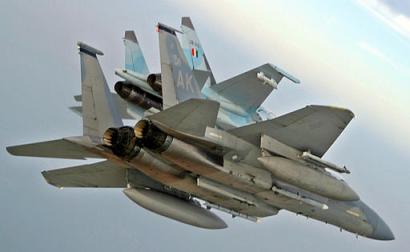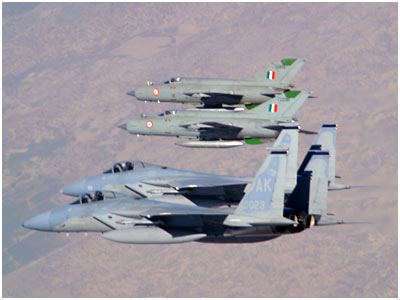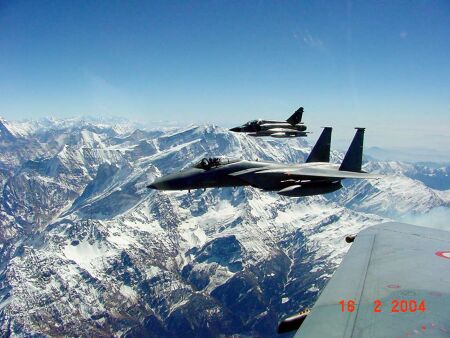
Home >> The IAF Today >> Exercise >>
VayuSena
© Inside The Air Force
By Hampton Stephens
[June 4, 2004]
A recent exercise with the Indian Air Force is causing U.S.
Air Force officials to re-evaluate the way the service trains its fighter pilots
while bolstering the case for buying the F/A-22 as a way to ensure continued air
dominance for the United States, according to service officials.
The surprising sophistication of Indian fighter aircraft and skill of Indian
pilots demonstrated at the Cope India air combat exercise Feb. 15 through 27 at
Gwalior Air Force Station, India, should provide a reality check for those who
had assumed unquestioned U.S. air superiority, service officials who
participated in the exercise said this week. The event was the first-ever air
combat exercise involving the U.S. and India and the most active bilateral
military exchange in over 40 years, according to these officials.
“The major takeaway for the Air Force is that our prediction of needing to
replace the F-15 with the F/A-22 is proving out as we get smarter and smarter
about other [countries’] capabilities around the world and what technology is
limited to in the F-15 airframe,” said Col. Mike Snodgrass, commander of the 3rd
Wing at Elmendorf Air Force Base, AK. “We’ve taken [the F-15] about as far as we
can and it’s now time to move to the next generation.” Snodgrass, who has been
selected to receive his first star, and two other wing officials spoke with
Inside the Air Force June 2.

The Air Force has been arguing the absolute necessity of the F/A-22 since the
program began. But the performance of the Indians in direct competition against
the Air Force’s best fighter, the F-15C, was particularly striking evidence of
an endangered U.S. lead in air combat capability, the statements of service
officials indicate.
Air Force Chief of Staff Gen. John Jumper told the Senate Appropriations defense
subcommittee in March that the results of Cope India were “very revealing,”
although he declined to elaborate in a public forum. Privately, other senior
service officials have pointed to Cope India as evidence that continued U.S. air
superiority is dependent on the F/A-22.
Although service officials have been reluctant to detail how the Indians
performed against the six F-15Cs from the 3rd Wing that participated in Cope
India, Rep. Duke Cunningham (R-CA) said in a Feb. 26 House Appropriations
defense subcommittee hearing that U.S. F-15Cs were defeated more than 90 percent
of the time in direct combat exercises against the IAF.
Officials from the 3rd Wing at Elmendorf did not provide specifics about how
their aircraft fared, but said the experience is causing the service to
reevaluate the way it trains its pilots for air-to-air operations.
“What happened to us was it looks like our red air training might not be as good
because the adversaries are better than we thought,” Snodgrass said. “And in the
case of the Indian Air Force both their training and some of their equipment was
better than we anticipated.”
“Red air” refers to the way the Air Force simulates enemy capability in air
combat training. Because the service has assumed for years that its fighters are
more capable than enemy aircraft, the U.S. pilots that simulate the enemy, known
as “red” forces, in air combat training are required to operate under rules that
constrain their combat capability.
“We have always believed that our technology was superior to everyone else’s
technology, that we would fight a somewhat inferior adversary, so we have had to
supply a simulated adversary from our own resources; we call that ‘red air,’”
Snodgrass said.

As a result, Air Force pilots are used to flying against an enemy whose combat
capability is deliberately limited.
“There are manoeuvering limits as well as weapons employment limits, what we
believe enemy aircraft may be able to do with their weapons systems, so we try
to simulate that in our own airplane with our own weapons,” Snodgrass explained.
“It becomes very complex because instead of using the airplane the way it was
designed, you now have to come up with rules of thumb that limit what you do and
cause you to not perform . . . the way we really would want to in combat.”
The Cope India exercises consisted of air combat maneuvers in which pilots would practice their fighter tactics and fly against each other one-on-one, as well as
simulated combat scenarios. It was during this simulated combat, which included
both “offensive counterair” and “defensive counterair” scenarios, that the
Indians proved the most formidable, according to the 3rd Wing officials. In the
offensive counterair scenarios, a small number of F-15Cs would attempt to
intercept an enemy strike aircraft en route to a target that was guarded by a
larger number of Indian fighters. In the defensive counterair missions, the
F-15s would attempt to defend a target against Indian fighters.
In these offensive and defensive missions, four F-15Cs were usually flying
against 10 or 12 of the same model Indian fighter, according to Col. Greg
Neubeck, deputy commander of operations for the wing’s 3rd Operations Group and
exercise director for Cope India. The 3rd Operations Group is responsible for
the 3rd Wing’s flying mission.
The Indians flew a number of different fighters, including the French-made
Mirage 2000 and the Russian-made MIG-27 and MIG-29, but the two most formidable
IAF aircraft proved to be the MIG-21 Bison, an upgraded version of the
Russian-made baseline MIG-21, and the SU-30K Flanker, also made in Russia,
Neubeck said. He emphasized the fact that U.S. forces were always outnumbered in
these scenarios, but said the missions proved more difficult than expected.

“What we faced were superior numbers, and an IAF pilot who was very proficient
in his aircraft and smart on tactics. That combination was tough for us to
overcome,” Neubeck said.
One reason the Indian pilots proved so formidable is that their training regimen
does not include a concept of “red air.” Instead, “they fly pretty much
blue-on-blue . . . [a] full-up airplane with no restrictions against somebody
else’s airplane with no restrictions, and that leads to more proficiency with
your aircraft,” Neubeck said.
In addition to reinforcing the need for the F/A-22, therefore, Cope India
demonstrated that the service might be able to immediately improve its air
combat capability by changing the way Air Force pilots train.
“The Air Force is re-examining, from what I can understand, our concept of red
air and how we might be able to provide red air to our fighter forces so that we
get [the best] training we can afford,” Snodgrass said.
Neubeck said the service probably needs to “take off the handcuffs that we put
on our red air training aids and allow them to be more aggressive and make the
red air tougher than we have in the past.”
Although India is a friendly nation, the lesson of Cope India is that almost any
nation could surpass the United States’ air combat capability if the Pentagon
does not continue to invest in better training and technology, the Elmendorf
officials said. At last count, for example, there were over 5,000 MIG-21s active
in air forces around the world, Snodgrass said. Even American fighters, such as
Boeing’s F-15, are being sold in upgraded versions to countries around the
world.
“I believe what this demonstrates is that the capacity exists out there for any
nation with the appropriate resources and the will to acquire technology and to
train their aircrews to be very, very capable,” said Col. Russ Handy, commander
of the 3rd Operations Group. “In the long term this could occur in nations
outside of the Indian Air Force.”
The Air Force will get another chance to test its capabilities against the
Indians in July, when the IAF will bring its Jaguar fighter-bomber aircraft to
Eielson AFB, AK, for the Cooperative Cope Thunder exercise. The 3rd Wing
officers said their pilots had not yet flown against an Indian-piloted Jaguar.
| The IAF Today | : | Exercise Red Flag 2008 - IAF Su-30MKI vs USAF F-15, F-16 and F-22 |
| The IAF Today | : | Cope India 2004 article from Vayu |
| The IAF Today | : | AWST: 3rd Wing explains Cope India Exercise |
| The IAF Today | : | Ex Golden Eagle |
| The IAF Today | : | How Su-30MK beats the F-15 in USAF Simulations |
| The IAF Today | : | Su-30MKI Vs F-16C and F/A-18E/F |
| The IAF Today | : | Su-30MK Vs Mirage-2000-5 |
| The IAF Today | : | Su-30MKI Info |
Comments or Questions? Contact Us
[Home] [The IAF Today] [Other Ops & Incidents] [Kargil 1999] [1980s] [1971] [1965] |
| Top |